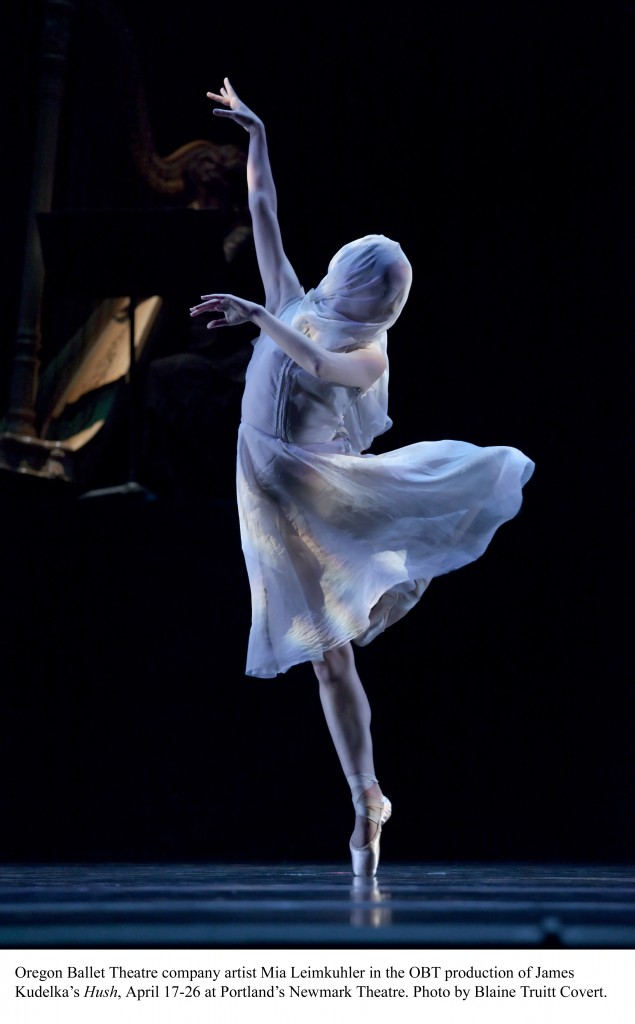 THE LATEST NEWS FROM OREGON BALLET THEATRE, which is struggling with a life-threatening deficit that has it feverishly trying to raise $750,000 by June 30 to keep from going out of business: The campaign hit the $524,000 mark by Wednesday. That morning OBT’s Erik Jones said 900 tickets were still available for Friday night’s gala benefit performance Dance United, which will bring star performers from across North America to raise money for OBT. Buy your tickets here — this could be the event on the season!
THE LATEST NEWS FROM OREGON BALLET THEATRE, which is struggling with a life-threatening deficit that has it feverishly trying to raise $750,000 by June 30 to keep from going out of business: The campaign hit the $524,000 mark by Wednesday. That morning OBT’s Erik Jones said 900 tickets were still available for Friday night’s gala benefit performance Dance United, which will bring star performers from across North America to raise money for OBT. Buy your tickets here — this could be the event on the season!
At Portland Arts Watch, meanwhile, Barry Johnson reports on the challenges OBT faces AFTER June 30.
And prominent national dance critic Martha Ullman West, who plies part of her trade (the pro bono part) here at Art Scatter, has some things to say below about last weekend’s season-ending program and how it revealed the necessity of keeping this company alive. She even took time to give her Scatter editor a scolding for something he posted on the subject: When you’re pro bono, you get to do that!
*******************************************************************
When I wrote on Monday in The Oregonian that the way Oregon Ballet Theatre‘s dancers performed The Concert last weekend clearly and painfully demonstrate how much we have to lose if the company folds, I didn’t mean the same assessment couldn’t be applied to the rest of what was a very difficult program.
 OBT’s season-finale program was designed to accomplish several goals, one of which was to challenge the dancers. And there is no getting around the fact that the work those dancers had performed most often — Rush, Afternoon of a Faun and The Concert — was polished to the accomplished shine you see only in major companies: New York City Ballet, San Francisco Ballet, Pacific Northwest Ballet, Houston Ballet and the like. These are troupes with far bigger budgets, many more dancers and far more opportunities to perform than OBT.
OBT’s season-finale program was designed to accomplish several goals, one of which was to challenge the dancers. And there is no getting around the fact that the work those dancers had performed most often — Rush, Afternoon of a Faun and The Concert — was polished to the accomplished shine you see only in major companies: New York City Ballet, San Francisco Ballet, Pacific Northwest Ballet, Houston Ballet and the like. These are troupes with far bigger budgets, many more dancers and far more opportunities to perform than OBT.
What Christopher Stowell, as artistic director, and Damara Bennett, as OBT School director, have accomplished in Portland in six years is truly remarkable. And it’s known throughout the country, which is why, when OBT announced its life-threatening financial emergency last month, so many artistic directors answered his call for help in the affirmative.
This company is extremely well-schooled. That was abundantly clear in Rush and in the second performance of The Cage on Saturday afternoon, as it was in the spring performances of William Forsythe’s The Vertiginous Thrill of Exactitude, which OBT’s dancers will perform in Friday’s benefit gala. I was startled when I returned from Kansas City last spring, having seen Kansas City Ballet the night before, by the contrast. KCB celebrated its 50th anniversary last year, but it’s OBT that has a true company style.
That’s an achievement for which Stowell, Bennett and ballet mistress Lisa Kipp can take credit. Most of these dancers had quite different training. Sure, there’s a cadre that has been to the School of American Ballet that includes Gavin Larsen, Adrian Fry, Lucas Threefoot (summer program), Christian Squires and Javier Ubell. But a number were trained in OBT’s school, at PNB or SFB. And the excellent Ronnie Underwood trained in Tulsa, so is part of the Ballets Russes strand of American ballet style. Artur Sultanov’s schooling was Russian, at the Vaganova Academy, and Chauncey Parsons, who joined as a soloist last fall, trained at the Kirov Academy in Washington, D.C. Parsons will show us some bravura Kirov style dancing at the gala. Yuka Iino — hardly second string, Mr. Hicks, as the Novice in The Cage at the matinee (nor was Grace Shibley in Faun) — trained in her native Japan, as did Ansa Deguchi.
Continue reading OBT’s ‘Rush + Robbins’: Some further thoughts

 Yes, charmed. And I thought, this is policymaking outside the channels of policy. Here, in Obama, is a man utterly at ease inside his own skin. That’s why people respond to him. Because he’s comfortable with himself.
Yes, charmed. And I thought, this is policymaking outside the channels of policy. Here, in Obama, is a man utterly at ease inside his own skin. That’s why people respond to him. Because he’s comfortable with himself.